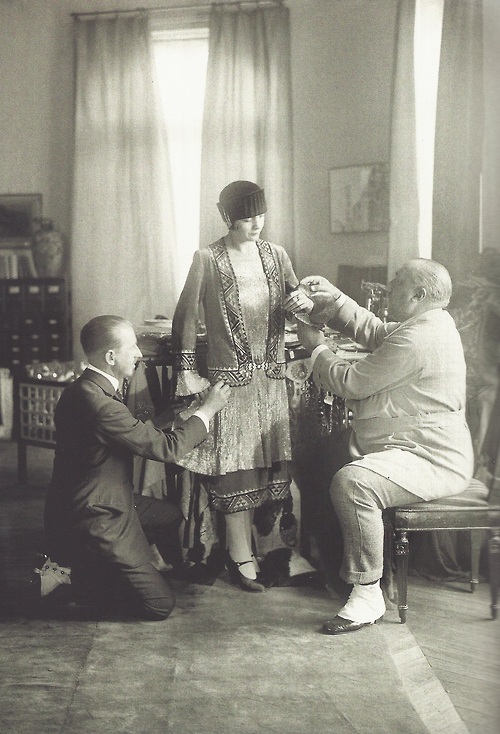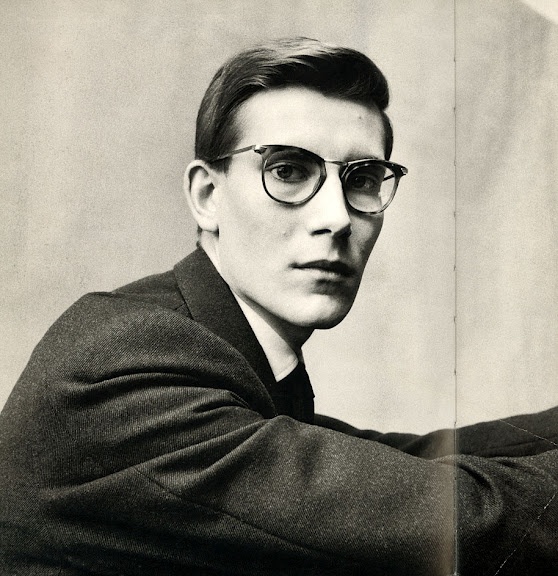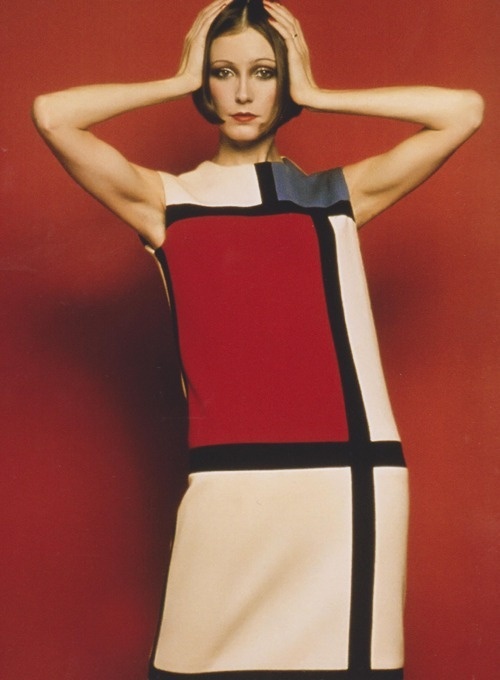Diamo
inizio ai post sulle tendenze autunno-inverno con l’Arte in Passerella: un
legame ricorrente (leggi sotto) eppure raramente avvistato in così tante
sfilate. Ecco la prima
parte del nostro focus con Carven, Giles, Dolce & Gabbana e Missoni. Nella seconda parte Chanel, Rochas, Lanvin, Moschino Cheap & Chic, N°21, Prabal Gurung e Gabriele Colangelo.
INTRODUZIONE
Arte e moda. Più che una tendenza una
combinazione naturale che riemerge ciclicamente. Sarà per la contiguità dei
settori e per la passione artistica della quasi totalità degli stilisti ma gli
esempi sono innumerevoli e vanno dalle collaborazioni - tra le più recenti quelle
di Louis Vuitton e Yayoi Kusama, Versace e Tim Roeloffs (f/w 2008),
Art and fashion. It’s more of a natural and cyclical combination than
a trend. Maybe it depends on the sectors’ contiguity and on the artistic
passion of the designers, but the examples are innumerable and go from the
partnerships - among the most recent there are those between Louis Vuitton and Yayoi Kusama, Versace and Tim Roeloffs (f/w 2008), Prada and James Jean
(s/s 2007) -
 |
| Tim Roeloffs - Herman Hesse, Tumblr |
Prada e
James Jean (s/s 2007) -
agli omaggi, come quello di Raf Simons a Picasso (Jil
Sander s/s 2012). Tuttavia se devo pensare a dei punti di riferimento entrati
nella storia, sono tre i nomi che mi vengono in mente.
All’origine del fenomeno
Paul Poiret
to the homages, like
that one by Raf Simons to Picasso (Jil Sander s/s 2012). The historic names
about art-fashion link are three.
Paul
Poiret involved many friends-artists in his work but especially Raoul Dufy, who since 1911 had drawn
the decorations and the patterns of Poiret
fabrics.
 |
| Paul Poiret - Paris, Octobre 1925, Tumblr |
che, tra i tanti amici
artisti variamente coinvolti nella sua attività, dal 1911 si affidò a Raoul Dufy per i decori e le stampe dei
suoi tessuti.
 |
| ©The Kyoto Costume Institute, photo by Takashi Hatakeyama
|
Vicenda a sé stante quella di Elsa Schiaparelli.
Anche la couturier gravitò sempre in ambienti artistici
ispirandosi al Dadaismo e al Surrealismo, ma lei e Salvador Dalì
furono artefici di un sodalizio che rappresenta l’emblema
stesso del binomio arte-moda; una collaborazione che fu anzitutto l’incontro
unico tra due personaggi sulla stessa lunghezza d’onda e che produsse pezzi
leggendari tra cui l’abito aragosta
Elsa Schiaparelli has always moved in the artistic circles drawing
inspiration from Dadaism and Surrealism. The association with Salvador Dalì was the symbol of the
binomial art-fashion and produced the lobster dress and the shoe hat, the tears
or the skeleton dresses and the telephone handbag.
 |
| Abito aragosta - Elsa Schiaparelli e Salvador Dalì - 1937, Pinterest |
e il cappello scarpa,
 |
| Gala Dalì col cappello scarpa - Elsa Schiaparelli e Salvador Dalì - 1936, Tumblr |
il vestito scheletro o quello strappato e la
borsa telefono. Infine, il caso più
celebre di trasposizione di opere d’arte ossia Yves Saint Laurent
Lastly we can’t forget the transposition of the
artworks by Yves Saint Laurent with
the Mondrian dress and the Tom Wesselmann dresses.
Glance at the fall-winter 2012/13 catwalks and at
their artistic currents.
 |
| Yves Saint Laurent - Irving Penn - 1957, Pinterest |
con l’abito Mondrian
 |
| Mondrian dress - Yves Saint Laurent - 1965, Pinterest |
 |
| Veronica Hamel in a Mondrian dress - 1965, Pinterest |
e i vestiti omaggio a Tom
Wesselmann e alla Pop Art.
 |
| Wesselmann dress sulla copertina di Life - 2 settembre 1966, Pinterest |
E
sulle passerelle dell’autunno-inverno 2012/13 quale corrente ha prevalso? Dal
Rinascimento ai giorni nostri, diamo uno sguardo.
1. CARVEN
+ HIERONYMUS BOSCH + ROSONI GOTICI
Guillaume Henry arricchisce il suo look fresco e très parisien con le suggestioni
artistico-spirituali di Hieronymus Bosch
e dei rosoni delle cattedrali gotiche. Il pannello centrale de Il
Giardino delle Delizie (1480/1490) di Bosch con la sua simbologia misteriosa e affascinante campeggia
virato in giallo su vestiti, bluse e gonne.
Allo stesso modo la complessa
geometria dei rosoni si ritrova su abiti e camicie in feltro tagliato a laser.
Hieronymus Bosch and the
rose windows of the gothic
cathedrals enrich the Guillaume Henry’s
cool and très parisien looks. The middle panel of The Garden of the Earthly
Delights (1480/1490) towers over dresses, blouses and skirts. In the same way the elaborate geometry of the rose windows characterizes laser-cut
felt dresses.
 |
| Il Giardino delle Delizie - Hieronymus Bosch, Tumblr |
2. GILES + ARAZZI FIAMMINGHI
Giles Deacon
ha immaginato per la sua sfilata la trama gotica di un castello in fiamme. Tra capi
bruciati e mise da personaggi alla Poe o alla Henry James, si distinguono
abiti, giacche e tuniche che sembrano ricavati da arazzi fiamminghi come quelli
delle serie La Dama e l’Unicorno (1484/1500) o La Caccia all’Unicorno (1495/1505). Bellissimo il vestito con
gonna boule e colletto da educanda.
Giles Deacon has devised
the gothic plot about a castle on fire. Dresses, jackets and tunics, derived
from Flemish tapestries like the
series The Lady and the Unicorn (1484/1500) and The Hunt of the Unicorn (1495/1505),
emerge among burned items and outfit a la Poe or Henry James.
3. DOLCE
& GABBANA + BAROCCO
In
una delle collezioni più belle degli ultimi anni, Domenico Dolce e Stefano
Gabbana hanno ripreso i temi della Sicilia e del Barocco declinandoli con particolare maestria. Il risultato è un
susseguirsi di abiti e bluse spumeggianti in cui trionfano ghirlande floreali
alla Juan de Arellano e putti (vedi anche gli orecchini) identici a quelli dilaganti
nei dipinti e negli altorilievi delle chiese settecentesche.
Splendidi i
ricami, i fregi e le volute dorate che richiamano paramenti sacri ma anche la
sontuosità di dimore nobiliari come Palazzo
Valguarnera-Gangi, lo stesso in cui venne girata la scena del ballo de Il Gattopardo.
Domenico Dolce and Stefano Gabbana have returned to Sicily
and Baroque themes: dresses and
blouses with flower chains a la Juan de
Arellano and little angels (see also the earrings) like those of the
eighteenth-century churches.
Golden embroideries, friezes and volutes recall the
aristocratic residences like Palazzo
Valguarnera-Gangi (the same palace, where the ball’s scene of Il
Gattopardo was shot).
5. MISSONI
+ VAN GOGH
Questa
è una mia personale visione e non ha niente a che vedere con l’ispirazione
naturale della collezione Missoni. È
un po’ come per le macchie di Rorschach in cui ognuno individua qualcosa.
Semplicemente questo abito e la sua lavorazione a spirale, così spessa e
materica, mi hanno ricordato i vortici di colore delle tele di Van Gogh. Adesso non prendetemi per
pazza.
This is my personal view and doesn’t concern the
natural inspiration of Missoni collection.
It’s like the Rorschach test: everybody sees a different thing. This dress and
his making remind me of the oil colours’ whirls of the Van Gogh paintings. Don’t consider me a madwoman.
Altre immagini:
1) Particolare de Il Giardino delle Delizie - Hieronymus Bosch,
Tumblr; 2) Rosone di Notre Dame,
Parigi; 3) Particolare de La Dama col Liocorno - La Vista, Tumblr; 4) L’Unicorno in Cattività
della serie La Caccia all’Unicorno,
Tumblr; 5) Juan de Arellano (1614-1676)
- Ghirlanda di Fiori con Uccelli e
Farfalle; 6) Carlo Maratta - Amorini con Ghirlande di Fiori; 7) Palazzo Valguarnera-Gangi, Palermo; 8) Particolare della chiesa dell’Immacolata Concezione, Palermo; 9) Vincent Van Gogh - Notte Stellata - 1889, Tumblr.
Etichette: arte e moda, Carven, ElectroFocusMode, Fall-Winter 2012-13, Giles, Missoni, Mode, trend













